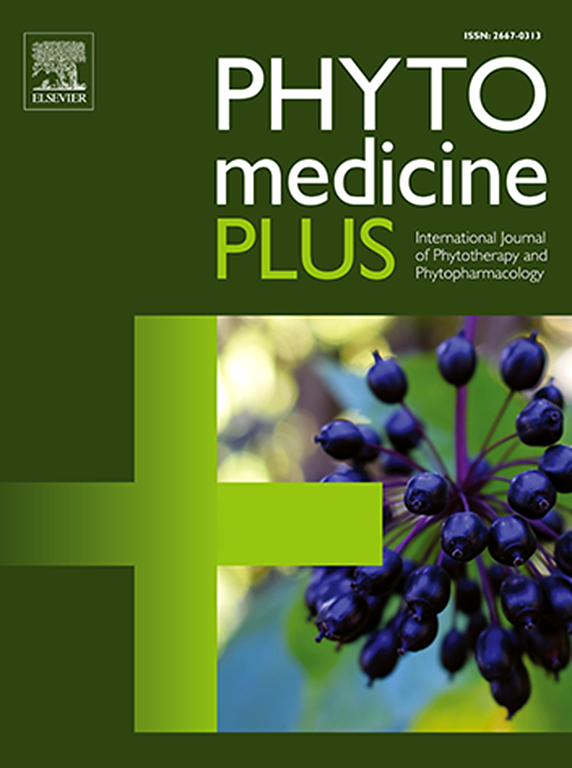Shramahara Mahakasya, a traditional polyherbal formulation, induces anti-anxiety activity in hippocampal neurons by effectuating SOD2-mediated protection against oxidative stress
Q3 Pharmacology, Toxicology and Pharmaceutics
引用次数: 0
Abstract
Background
Shramahara Mahakasya (SM) is an Ayurvedic polyherbal formulation known for its anti-fatigue and anti-anxiety effects on the human body. However, its mechanism of action remains largely unexplored. In this study, we investigated the intricate mechanisms through which SM polyherbal extract exerts neuroprotective and anxiolytic effects in cultured HT-22 cells and rodent models.
Method
In this study, the chemical composition of SM was first identified using gas chromatography-mass spectrometry (GC-MS) and liquid chromatography-mass spectrometry (LC-MS). The antioxidant potential of SM was evaluated through antioxidant assays such as DPPH, ABTS and FRAP. The neuroprotective activity of SM (200 and 600 μg/mL) was investigated in glutamate (10 mM) assaulted HT-22 cells. The anxiolytic activity of SM (50 and 100 mg/kg) was assessed in a caffeine (50 mg/kg) induced anxiety model of Sprague Dawley rats. The possible underlying mechanisms for the neuroprotective and anxiolytic activities of SM were explored through biochemical assays and brain histology.
Results
Our findings suggest that SM has antioxidant and neuroprotective potential, as evidenced by a decrease in ROS accumulation, Ca2+ overload, mitochondrial membrane potential (MMP) loss, and apoptosis in HT-22 cells subjected to glutamate-induced oxidative stress. The extract also increased SOD2 levels and decreased cleaved caspase-3 levels across various treatment sets. The anxiolytic activity of SM was demonstrated by improved behavior of the animals in the elevated plus maze test and increased SOD activity in the brain. SM exhibited the most effective improvements in anxiety disorder at a dose of 100 mg/kg body weight in rats.
Conclusions
This study is a pioneering investigation depicting the antioxidant, neuroprotective, anti-apoptotic, and anxiolytic potential of SM formulation against glutamate/caffeine-induced oxidative stress and anxiety in both in vitro and in vivo situations. Overall, our study suggests that the regular consumption of SM formulation could effectively prevent anxiety symptoms by reducing oxidative stress in neuronal cells.

Shramahara Mahakasya是一种传统的多草药配方,通过sod2介导的氧化应激保护作用,诱导海马神经元抗焦虑活性
shramahara Mahakasya (SM)是一种印度草药配方,以其对人体的抗疲劳和抗焦虑作用而闻名。然而,其作用机制在很大程度上仍未被探索。在本研究中,我们研究了SM多草药提取物在培养HT-22细胞和啮齿动物模型中发挥神经保护和抗焦虑作用的复杂机制。方法首次采用气相色谱-质谱联用(GC-MS)和液相色谱-质谱联用(LC-MS)对SM的化学成分进行鉴定。通过DPPH、ABTS、FRAP等抗氧化指标评价SM的抗氧化能力。研究SM(200和600 μg/mL)对谷氨酸(10 mM)侵袭HT-22细胞的神经保护作用。采用咖啡因(50 mg/kg)诱导的Sprague Dawley大鼠焦虑模型,评价SM(50和100 mg/kg)的抗焦虑活性。通过生化分析和脑组织组织学分析,探讨了SM神经保护和抗焦虑作用的可能机制。结果SM具有抗氧化和神经保护作用,可以减少谷氨酸诱导的氧化应激下HT-22细胞的ROS积累、Ca2+超载、线粒体膜电位(MMP)损失和凋亡。在不同的处理组中,提取物也增加了SOD2水平,降低了cleaved - caspase-3水平。SM的抗焦虑活性通过小鼠在升高+迷宫实验中的行为改善和大脑中SOD活性的增加得到证实。SM对大鼠焦虑障碍的改善作用在100 mg/kg体重剂量下最为有效。结论SM制剂在体外和体内均具有抗氧化、神经保护、抗凋亡和抗焦虑的作用。总之,我们的研究表明,经常服用SM制剂可以通过减少神经元细胞的氧化应激来有效预防焦虑症状。
本文章由计算机程序翻译,如有差异,请以英文原文为准。
求助全文
约1分钟内获得全文
求助全文
来源期刊

Phytomedicine Plus
Medicine-Complementary and Alternative Medicine
CiteScore
3.70
自引率
0.00%
发文量
178
审稿时长
81 days
期刊介绍:
 求助内容:
求助内容: 应助结果提醒方式:
应助结果提醒方式:


